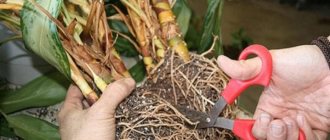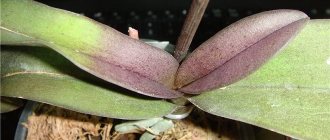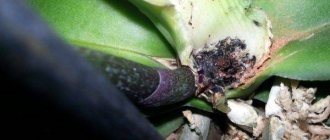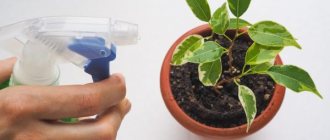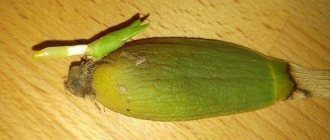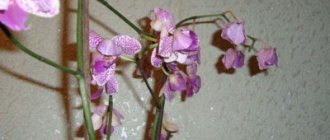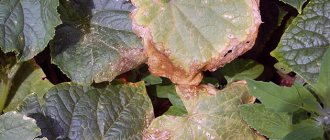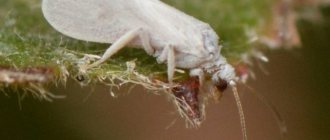Orchid diseases, unfortunately, are not uncommon. The plants are very popular in the home flower garden. This is largely due to its simple care (many consider the orchid to be a complex and capricious plant, but this is not so, because maintaining temperature, moisture and bathing once a week is enough) and flowering almost all year round. Nowadays it is quite difficult to find complete information about the correct maintenance of a flower, so diseases often accompany this plant. Let's look at what diseases are considered the most common, as well as how to properly treat them at home.
Types of pigmentation
Pigmentation can be distinguished by several types of characteristics:
- size (there may be absolutely unnoticeable spots, which at a long distance in large numbers appear to be one large spot, and sometimes very large inclusions appear);
- color (all shades of yellow, brown, dark and black are found);
- shape (most often these are round spots, but the edges are not always smooth; they can be smooth, convex or, conversely, concave).
What do lesions look like?
On some sites, the manifestation in question is called “pigmentation.” This definition is completely incorrect. The spots that form on the leaves of the phalaenopsis orchid are always necrosis, that is, local tissue necrosis.
They happen:
- dark (brown, brown, black or even purple);
- light (whitish, yellow, red).
The spots vary in size. Sometimes these are small dots, and often they are large lesions of a regular round shape or lack clear boundaries.
Some lesions look like blisters, others, on the contrary, seem to be depressed. They are usually moist and sticky, and less often they are completely dry.
Where do they appear?
In principle, there is no part of the phalaenopsis where a speck could appear. However, they are most regularly found on the leaves.
It’s worse when the lesions spread through the root system. Here it is almost impossible to detect them in a timely manner.
In the latter situation, the presence of a problem is indicated only by the unhealthy appearance of the orchid and its slow withering.
Photo
You will see a photo of black and other dots on the flower:
Mold
The formation of mold on a flower indicates the presence of fungi, which quickly spread through the air using microscopic spores.
A signal of mold infection is indicated by the formation of moldy fluff on the surface of leaves, roots or substrate.
Mold can be of different colors, depending on what pathogen has settled on the flower and can range from light gray to greenish. On orchids you can most often find white and black mold.
In order to get rid of mold, it is necessary to transplant the flower into new soil and pot, having previously treated all parts with a solution of copper sulfate.
Which inclusions are dangerous and which are not?
It is very difficult to say exactly what is dangerous for a plant. However, most often, if the inclusions are barely noticeable (small in size or the color of the pigmentation is not very different from the phalaenopsis area), this indicates that they are most likely not a cause for concern.
Reference! It's important to keep an eye on these types of spots because they can develop into something more serious. The main thing is to notice changes in time and take measures to eliminate them.
Lumps and pimples
The tubercles and pimples are mycelium in its infancy. Over time, they will increase in size, burst and spores and mycelia will begin to spread throughout the plant. Opening such blisters is strictly not recommended. It is necessary to immediately cut off the painful leaf.
Such manifestations may indicate the colonization of an adult female pseudoscale insect. Pests feed on juices from tissues and leave a viscous, sticky liquid on them, which creates conditions for the development of rot and fungi.
Reasons for appearance
There can be many reasons for such a negative process in the life of a plant. Let's call them:
- Burning by the sun's rays. To avoid this, you need to choose the right location for your beauty. There should be a lot of light, but it should be diffused.
- Incorrectly selected watering mode. Often it is excessive soil moisture that leads to spots on the plant. This occurs due to rotting of the root system.
- Poor air and water circulation in the pot. A drainage layer will help ensure the movement of air and water in the flower container. Its height should vary between 1.5-2 centimeters. You also need to make sure there are holes at the bottom of the pot.
- Lack of fresh air in the room. The room needs to be ventilated regularly. However, this procedure should not turn into drafts. Everything should be in moderation.
- Mistakes in choosing a pot. The container for phalaenopsis should be a couple of centimeters in diameter larger than the volume of the entire root system. This will ensure normal growth and healthy development for the roots (you can learn more about how to care for orchid roots to keep them healthy here).
Poor quality substrate. The soil should be intended exclusively for the Orchid family. Others won't work. It is necessary to ensure that after moistening the soil does not form lumps, and also that bark is present in the soil mixture.- Improper use of fertilizer. Often the gardener, wanting even faster growth, development and flowering of phalaenopsis, overdoes it with fertilizing. Under no circumstances should this be done. It is important to strictly follow the instructions for use.
Rot on the roots
Keep in mind that the roots can be affected by both rot and fungus. They are often affected by such types of rot as:
- Gray. It affects both roots and leaves. The presence of a problem can be determined by dark areas with a gray coating in different parts of the plant. Often the problem concerns the leaves. After them, the soil, roots, and flowers suffer. The cause of rot is high air humidity and low room temperature. Excessive use of fertilizers with a high concentration of nitrogen can also affect the appearance of gray rot. Keep in mind that gray mold is a fungus. If spots are found, remove all affected areas by cutting out and spray healthy areas with fungicides. If it reappears, you cannot use the same drug; you need to select another one. The appearance of gray mold is typical for cattleya, phalaenopsis, cymbidium and other varieties of orchids with white flowers. For prevention, when watering, you need to use drugs to enhance the resistance of orchids to diseases; in addition, do not place orchids close to each other.
- Root. It appears on the roots of the plant. They become soft and die over time. Brown leaves are another indication of the presence of the disease. The cause of root rot is high temperature and humidity in the room. If you have already seen a problem, spray the roots with a solution of foundationazole (0.2%) or topsin (0.2%). Repeat the procedure three times every 20 days. The disease often affects Cymbidium, Miltonia and Paphiopedilum. Prevention can be achieved by using a high-quality substrate.
All of these problems with the root system of orchids are considered the most common. Moreover, in most cases it is possible to cope with them. The main thing is to notice the problem in time and quickly begin treatment.
Danger to the flower
Any change in the appearance of the plant, including the appearance of inclusions, is a sign of the development of a disease. This can happen due to improper care, and sometimes the disease is transmitted from a diseased flower to a healthy one. The disease leads to the death of the flower completely or the death of some part of it. Therefore, the main task of the gardener is to monitor the appearance of the phalaenopsis and respond in a timely manner to the slightest changes.
Preventive measures
To effectively prevent the appearance of spots on phalaenopsis, it is necessary to properly organize its care:
- Do not injure the plant.
- Adjust the indoor microclimate.
- Inspect the plant.
- Wash the leaves and pot regularly.
- At the first signs of disease, remove the affected area to save the plant itself.
- Carefully approach the treatment of the plant, using special means.
Phalaenopsis are very selective and delicate flowers. They are picky about their living conditions. Any minor change in the environment leads to disease, wilting, loss of flowers and even death. It is important to monitor any changes in the color of the leaves, the appearance of spots on the plant, and promptly apply measures to treat the orchid.
Step-by-step instructions for treating inclusions caused by diseases
Bacillus Cypriped
It is necessary to begin the fight against such a disease immediately, since its negative impact spreads at a rapid speed and leads to the death of the flower.
How to recognize? Spots begin to appear on the edge of the leaf blade and literally reach its base in a day or two. In addition, the leaves lose their turgor and emit a characteristic unpleasant odor.
The most optimal way to combat Bacillus Cypriped is to remove the affected leaves and one-time spraying with insecticides.
Hives
Characteristic signs are miniature spots, the diameter of which does not exceed three millimeters, of a brown hue. Hives usually spread only on the leaves (you can learn more about what other diseases can occur on the leaves of the phalaenopsis orchid and how to treat them here).
To eliminate this disease, the grower must:
- increase the air temperature in the room to the optimum (in summer it is 22-26, and in winter – 18-23);
- increase the air humidity level to approximately 70%.
Late blight
You can recognize this disease by the following sign - black rot at the base of the leaf, which gradually spreads over its entire area. The danger of late blight lies in the fact that its pathogenic spores can persist in the soil for a long time.
It is almost impossible to save a plant after infection with this disease. Therefore, it is necessary to adhere to the following rules that will help avoid late blight:
- keep air humidity at 70-75%;
- do not overcool phalaenopsis;
- Make sure that after watering no drops of water remain on the surface of the plant.
Dry spots
This pigmentation can be either dark or light. However, it is impossible to cure a flower from dry spots. Because usually such inclusions are signs of burns. You can get rid of them by removing the burned area or the entire part of the plant. It's best to avoid dry patches. This can be done by following simple recommendations:
- in cold weather, make sure that the plant does not have direct contact with heat sources (this can be heating or lighting devices);
- starting in spring, make sure that direct rays of the sun do not fall on the phalaenopsis (it is better to generally move the flower to the eastern or western side of the room, or shade it).
Reference! In rare cases, dry spots appear due to an attack of fungal infections. In such a situation, the plant is treated with a fungicidal agent, and in the future the grower must control the air circulation in the room.
Mesophyll collapse
A characteristic feature of this disease is uneven spots of a yellow tint, which also have dented leaves (read more about why the leaves of the phalaenopsis orchid turn yellow and what to do to save them).
Botanists say that Mesophyll collapse appears due to watering or spraying phalaenopsis with water at low temperatures.
Orchid pests
Why do Decembrist leaves wither and fall off - what to do
Due to harmful insects, not only spots appear on the orchid, but also a sticky coating on the leaves. Insects often act as distributors of infectious diseases. Flower pests include: scale insects, mealybugs, rootbugs, aphids, whiteflies and fungus gnats.
Shchitovka
The insect settles on the trunk of a flower or under the leaves, which is why tubercles form on them. This is how the pest protects its eggs, from which new individuals emerge and spread throughout the plant. The parasites suck out the sap, covering the leaf with a sticky coating. This is an excellent environment for the appearance of sooty fungus, which clogs the pores on the tissues of the flower. As a result, the plant acutely feels a lack of oxygen.
You can save the orchid if you clean off all the tubercles and treat it with an insecticidal agent that has a gastrointestinal effect. When used, the plant absorbs the poison and becomes poisonous itself. The scale insect that sucks the juice is poisoned and dies. Dried “plaques” are removed with a toothbrush, after which the treatment is repeated.
Scale insect on an orchid
Chervetsy
If small mealybugs have settled on an orchid, it is very difficult to remove them. Microscopically, the parasites hide in the buds and reproduce as larvae. The scale insect entangles the larva with threads, attaching it to the plant so that the hatched individuals can feed. Adult parasites and larvae suck the juice of the flower. Small spots remain on the leaves. A weakened plant loses its ability to resist disease. The pest can be destroyed with an insecticidal agent that penetrates the gastrointestinal tract of the parasites.
It is more difficult to treat a plant if the bug has settled on the roots. Rootbugs are similar to mealybugs, but smaller in size. It is impossible to see the pest under the soil layer, but its presence can be judged by the leaves drooping down, yellow spots on them and the gradual wrinkling of the plates due to lack of nutrition.
Important! For prevention purposes, dry insecticide can be poured into the flowerpot. During watering, it will dissolve and, together with the water, will reach the roots.
Aphid
If the orchid has sticky spots on the flowers, this is a sign of aphid infestation. The insect reproduces very quickly, feeds on cell sap, so damaged leaves are sticky. Subsequently, a fungus develops on them. The light green pests blend in with the leaves, so they may not be noticed at first. When the leaves on the plant begin to curl, you need to sound the alarm. They fight the pest using chemical insecticides, biological products or folk remedies.
New pest - aphid
Whitefly
The appearance of white streaks on leaves and stems indicates the appearance of a whitefly, an insect that resembles a moth. The pest is very dangerous because it sucks the juice from the orchid tissue. If a butterfly flies near a flower, you need to move it to a cool place, spray it with poison and wrap it in a bag to create a greenhouse effect.
Fungus gnats
In early spring, fungus gnats (sciarids) may appear in flowerpots. This is due to the fact that in the spring, when there is not enough solar heat, the soil does not dry out well, and the room becomes cool. To kill mosquitoes, you need to dry the soil or replace it with fresh soil and cover it with sand. Additionally, you need to treat the soil with an insecticide.
Methods of treatment if the pathogen is bacteria
Phyllostictina Pyriformis
When infected with this bacterium, pigmentation appears on the plant (it can be either yellow or black). The size of such spots does not exceed a few millimeters. A distinctive feature of these inclusions is the fact that they do not grow for a long time. This is where the danger lies. Because during such “stagnation” the bacterium develops inside the tissue. And after that the leaf plate dies. This occurs approximately 10-15 days after the spots appear.
What can you do with the flower to eliminate yellow or black spots? Unfortunately, it will not be possible to save an orchid after infection. But it is possible to prevent the appearance of Phyllostictina Pyriformis. To do this, you need to ensure that the water in the pot does not stagnate.
Burkholderia gladioli
In our climatic conditions, such a bacterium is extremely rare. This pest leads to darkening of almost the entire surface of the leaf (read about what other pests of phalaenopsis orchids you should be wary of here).
Reference! The lesion is similar to frostbite.
To avoid infection, you need to control the air temperature in the room, preventing it from cooling.
Chlorosis
Signs of damage are large spots that do not have a clear boundary. Their color is light. Chlorosis is not considered a disease, but rather a precursor to it.
This bacterium appears for many reasons: both due to erroneous soil moisture and due to an incorrectly selected fertilizer complex.
An orchid is a finicky flower and, as a result, roots and other parts of the plant may dry out, leaves, flowers and buds may wither, and a sticky coating may appear. How to treat and save a flower using the root extension method - read on our Internet portal.
Why does it bloom, but the plates dry, wither and fall off?
Problems with an orchid's leaf system are always the result of improper care.
Main causes of diseases:
- overheat;
- frostbite or a long period of exposure to a draft;
- not regular watering, which led to drought or excessive watering of the flower;
- root system diseases;
- the presence of harmful insects that are located in the soil, root system or on leaves.
Natural wilting occurs when their life cycle is over.
This usually happens with lower single plates. After the leaves wither, they need to be carefully cut off. After some time, new upper green leaves appear on the orchid.
Prevention
It is easier to prevent any problem than to solve it later. The same is true with spots on phalaenopsis. They can be avoided by adhering to the following rules:
- Proper watering. Moisten the soil again only after it has stood dry for 2-3 days. Flower growers recommend watering phalaenopsis using the immersion method.
- Comfortable air temperature. Do not forget about the mandatory difference in waste temperature (the difference is approximately 4-5 degrees).
- Light mode. It is necessary to provide lighting for the plant for 10-12 hours a day. But be careful that direct sunlight does not fall on the flower.
- Feeding. Phalaenopsis should be fertilized twice a month. It is worth stopping feeding during flowering.
- Soil selection. It should contain bark, moss, river sand and peat. And also do not forget about a good drainage layer.
All these recommendations will help the gardener maintain the health and beauty of his pet.
White plaque
White plaque is a signal of powdery mildew disease. Spots on the leaves appear gradually, but over time they will cover the entire ground layer of the orchid. The culprit is the mealybug, which feeds on the sap of the plant and produces a harmful toxin.
In addition to using medications to treat powdery mildew, it is necessary to change the soil. Pests can hide in the pores.
What diseases are detected in the presence of black spots and dots on orchid leaves?
Why did these symptoms appear in the plant? The cause of most orchid diseases, which are non-infectious in nature, can be safely considered to be inappropriate conditions of detention . In addition, poor care weakens the plant, causing the appearance of phytopathogens:
- Microscopic fungi. Causes damage to leaves and stems. A likely factor is low cultivation temperatures coupled with high humidity.
- Bacteria. More often they develop when any part of the orchid is injured or cause rotting due to stagnation of moisture.
- Viral diseases. Associated with the physiological characteristics of the plant.
To restore the health of an orchid, first of all, it is necessary to find out the cause of the disease and know how to eliminate it.


